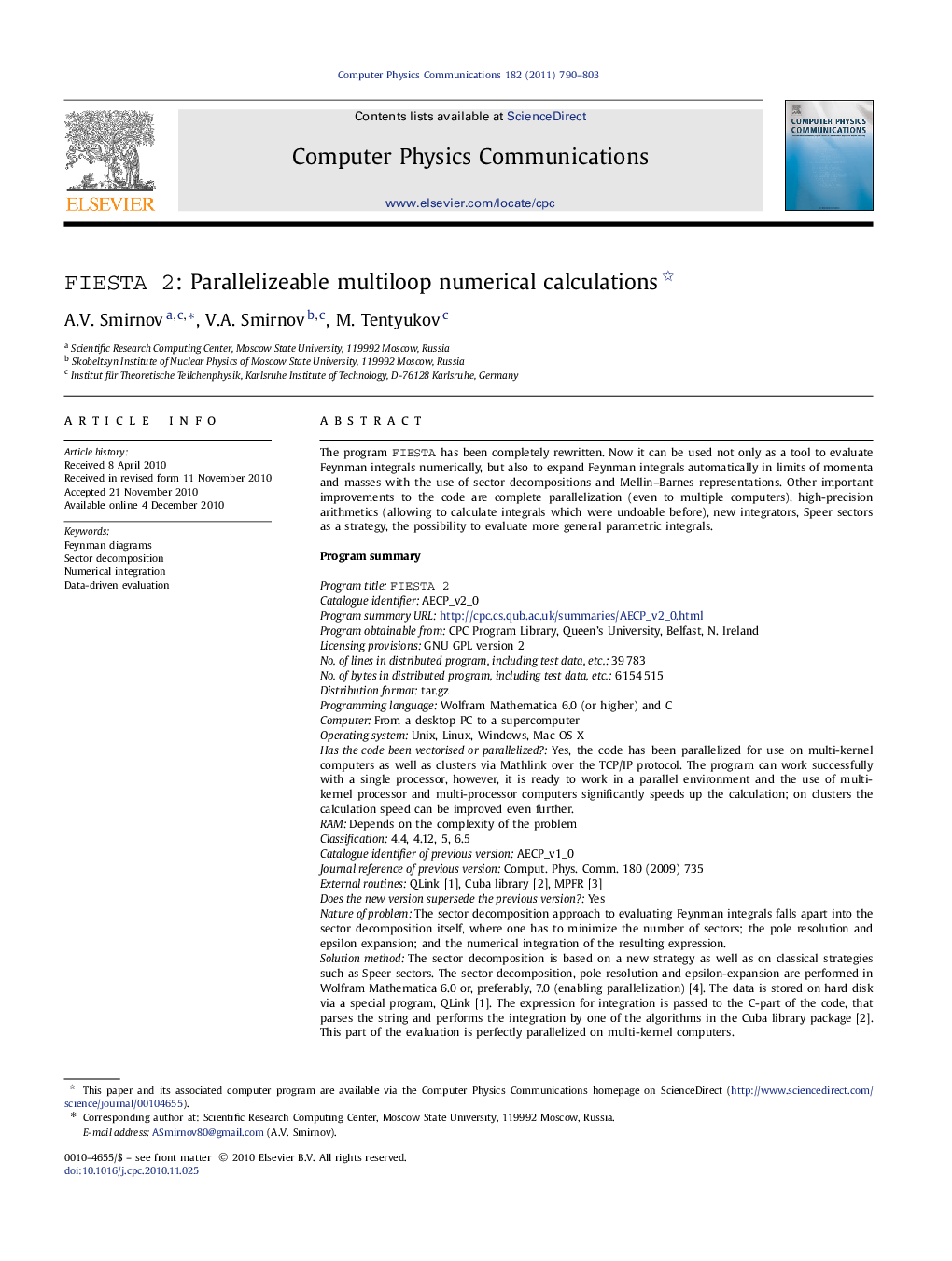| کد مقاله | کد نشریه | سال انتشار | مقاله انگلیسی | نسخه تمام متن |
|---|---|---|---|---|
| 502314 | 863700 | 2011 | 14 صفحه PDF | دانلود رایگان |

The program FIESTA has been completely rewritten. Now it can be used not only as a tool to evaluate Feynman integrals numerically, but also to expand Feynman integrals automatically in limits of momenta and masses with the use of sector decompositions and Mellin–Barnes representations. Other important improvements to the code are complete parallelization (even to multiple computers), high-precision arithmetics (allowing to calculate integrals which were undoable before), new integrators, Speer sectors as a strategy, the possibility to evaluate more general parametric integrals.Program summaryProgram title:FIESTA 2Catalogue identifier: AECP_v2_0Program summary URL:http://cpc.cs.qub.ac.uk/summaries/AECP_v2_0.htmlProgram obtainable from: CPC Program Library, Queen's University, Belfast, N. IrelandLicensing provisions: GNU GPL version 2No. of lines in distributed program, including test data, etc.: 39 783No. of bytes in distributed program, including test data, etc.: 6 154 515Distribution format: tar.gzProgramming language: Wolfram Mathematica 6.0 (or higher) and CComputer: From a desktop PC to a supercomputerOperating system: Unix, Linux, Windows, Mac OS XHas the code been vectorised or parallelized?: Yes, the code has been parallelized for use on multi-kernel computers as well as clusters via Mathlink over the TCP/IP protocol. The program can work successfully with a single processor, however, it is ready to work in a parallel environment and the use of multi-kernel processor and multi-processor computers significantly speeds up the calculation; on clusters the calculation speed can be improved even further.RAM: Depends on the complexity of the problemClassification: 4.4, 4.12, 5, 6.5Catalogue identifier of previous version: AECP_v1_0Journal reference of previous version: Comput. Phys. Comm. 180 (2009) 735External routines: QLink [1], Cuba library [2], MPFR [3]Does the new version supersede the previous version?: YesNature of problem: The sector decomposition approach to evaluating Feynman integrals falls apart into the sector decomposition itself, where one has to minimize the number of sectors; the pole resolution and epsilon expansion; and the numerical integration of the resulting expression.Solution method: The sector decomposition is based on a new strategy as well as on classical strategies such as Speer sectors. The sector decomposition, pole resolution and epsilon-expansion are performed in Wolfram Mathematica 6.0 or, preferably, 7.0 (enabling parallelization) [4]. The data is stored on hard disk via a special program, QLink [1]. The expression for integration is passed to the C-part of the code, that parses the string and performs the integration by one of the algorithms in the Cuba library package [2]. This part of the evaluation is perfectly parallelized on multi-kernel computers.Reasons for new version:1.The first version of FIESTA had problems related to numerical instability, so for some classes of integrals it could not produce a result.2.The sector decomposition method can be applied not only for integral calculation.Summary of revisions:1.New integrator library is used.2.New methods to deal with numerical instability (MPFR library).3.Parallelization in Mathematica.4.Parallelization on multiple computers via TCP-IP.5.New sector decomposition strategy (Speer sectors).6.Possibility of using FIESTA to for integral expansion.7.Possibility of using FIESTA to discover poles in d.8.New negative terms resolution strategies.Restrictions: The complexity of the problem is mostly restricted by CPU time required to perform the evaluation of the integralRunning time: Depends on the complexity of the problemReferences:[1]http://qlink08.sourceforge.net, open source.[2]http://www.feynarts.de/cuba/, open source.[3]http://www.mpfr.org/, open source.[4]http://www.wolfram.com/products/mathematica/index.html.
Journal: Computer Physics Communications - Volume 182, Issue 3, March 2011, Pages 790–803